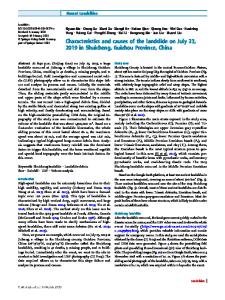Preliminary analysis of a rainfall-induced landslide hazard chain in Enshi City, Hubei Province, China in July 2020
- PDF / 3,986,586 Bytes
- 4 Pages / 595.276 x 790.866 pts Page_size
- 50 Downloads / 371 Views
Danyi Shen I Zhenming Shi I Ming Peng I Limin Zhang I Yan Zhu
Preliminary analysis of a rainfall-induced landslide hazard chain in Enshi City, Hubei Province, China in July 2020 Introduction Due to continuous rainfall from June to August 2020, Shaziba Town in Mazhe County, Hubei Province, China (N 30° 36′ 5′′, E 109° 29′ 85′′), experienced a catastrophic landslide at UTC + 8 5:30 on 21 July 2020. The location of the landslide was about 30 km from Enshi City and 480.5 km from Wuhan City (Fig. 1). The volume of the landslide was approximately 2.8 million m3. The landslide damaged more than 60 houses; some of them fell down entirely. Numerous cracks have developed on the ground and houses; cracks also formed and extended over 700 m on the Tunyu Highway (Fig. 2). About 0.25 million m3 of soil slid into the Qingjiang River, forming a landslide dam (Fig. 3). The landslide dam was overtopped and breached 4.25 h after its formation. The breaching peak flow rate was approximately 200 m3 /s. The breaching flood carried a large amount of sediment into the downstream channel, forming a rather flat riverbed. Fortunately, no death was caused by this event because the people in the affected areas were warned and evacuated 3 days before, as rapidly developing and observable ground cracks were found and served as a precursor (Fig. 2(b)). The azimuth of the sliding direction was approximately 195°. The landslide scar was 1,200–1,500 m long, 320–580 m wide and 25 m deep on average, and its volume was approximately 2.8 million m3. The landslide dam was estimated at 8–0 m high, 60–80 m long, and 300–350 m wide, and its lake volume was approximately 0.30 million m3. Preliminary analysis of the Shaziba landslide and landslide dam Geological conditions The Shaziba landslide was located in a folded mountain area in the southwest of Hubei. The terrain is generally high in the south and low in the north. The highest point of the mountain in the south of the landslide is 1,577 m, and the lowest point is the Qingjiang River valley in front of the landslide, with a water surface elevation of about 560 m. Peng et al. (2017) studied a 1000 km2 area that included the Shaziba landslide and found this region highly susceptible to landslides. They analyzed 119 landslides in this region and observed that 71% of these previous landslides developed in two strata: the Silurian formation, which is composed of quartzsandstone interbedded shale and the Badong formation, which is composed of silty mudstone. The Shaziba landslide was located in a Silurian stratum area. The Shaziba landslide was at the left bank of the river, which flows from west to east. The highest point of the landslide scar was about 950 m. Quaternary overburden is widely distributed on the
surface of the landslide area. The lower stratum is Silurian quartz sandstone interbedded shale, with a clay mineral content up to 40% (Zeng 2009). The landslide was mainly developed in loose deposits of Quaternary overburden. Such geological and topographical features provide rich materials and condi
Data Loading...











